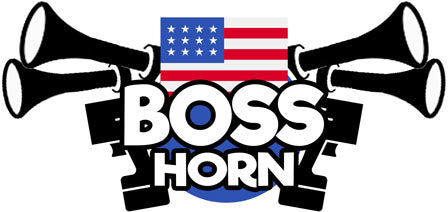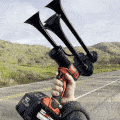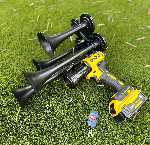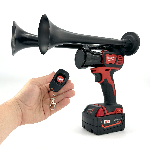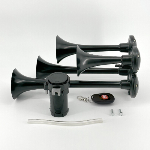Train toots, those iconic sounds of locomotives, serve as a vital communication tool in the rail industry, conveying signals of distance, warning, and presence. Each toot carries with it a meaning and purpose, reflecting the operational needs of trains as they navigate tracks and intersections. Understanding the nuances of these sounds not only deepens our appreciation for rail transport but also highlights the rich history and evolution of locomotion. So, let’s embark on a journey to explore the intricacies of train toots, from their traditional roots to their modern interpretations.
The Dewalt Train Horn, a powerful and portable handheld device, offers an innovative way to mimic the classic sounds of locomotives, especially useful for those needing robust auditory signals in various scenarios, from construction sites to outdoor events. With its impressive reach of up to 150 decibels and a remote control that operates from nearly 160 feet away, the Dewalt Horn makes it easy to deliver loud, attention-grabbing toots at a moment's notice. Whether you're aiming to create a memorable atmosphere or ensure safety during operations, this versatile horn provides a practical solution. Continue reading to fully dive into train toots and uncover their fascinating role in the world of locomotives.
The Dewalt Train Horn can serve as a fascinating tool for understanding the sound dynamics of locomotives. Train toots are not just mere noises; they are signals that communicate essential information about the trains' presence, intentions, and warnings to those nearby. The resonant sound of a train horn cuts through the air and can evoke a sense of nostalgia or even urgency, reminding us of the powerful machines that traverse our landscapes. By utilizing the Dewalt Train Horn, enthusiasts and professionals alike can explore this acoustic world, replicating the distinct sounds that have become synonymous with rail travel.
If you're interested in elevating your experience with train sounds, consider checking out the collection of Dewalt Train Horns. These portable handheld devices come equipped with remote control functionality, allowing operation from up to 160ft away, and capable of reaching sound levels up to 150db, depending on the model. Transform your understanding of locomotive acoustics and bring the power of train horns into your hands with the Dewalt Train Horn, perfect for creating a dramatic auditory experience wherever you go.
What Are Train Toots
Train toots, the distinctive sounds made by locomotives, serve various essential functions in rail transport. These toots usually originate from the train's horn, designed to alert nearby pedestrians and vehicles of an approaching train. Understanding this sound not only illuminates the operational aspects of railways but also the measures taken to ensure safety in transit.
Train Toots Understanding the Sound of Locomotives
The sound of train toots signals several key aspects of train operation. Different durations and patterns can indicate specific messages; for example, a long blast often warns of an approaching train at a crossing. Notably, regulations mandate the use of these horns in many locations, contributing to safety awareness among those near railway lines. As noted by railway expert Dr. John Ashford, “The toots are not just noise; they are a crucial part of our transport safety system.”
10 Impressive World Facts About Train Toots
1. The sound of a train horn can reach up to 110 decibels, making it louder than a rock concert.
2. The number of toots and their duration varies by country due to local regulations.
3. In the United States, trains are required to use their horns at grade crossings.
4. The typical sound pattern for a train horn is two long toots followed by one short.
5. In Japan, trains use quieter horns to minimize disturbance to nearby residents.
6. Some locomotives have custom horns to reflect local culture.
7. In the UK, the use of horns is regulated by the British Railways Act.
8. Train toots can carry over distances of two miles in rural areas.
9. Many railroads use digital sound recordings to enhance safety measures.
10. Train toots can be affected by weather conditions, altering their perceived volume and clarity.
10 Useful but Tricky Recommendations on Train Toots Understanding the Sound of Locomotives
1. Familiarize yourself with the specific toot patterns used in your region.
2. Always listen for toots when near railway tracks, especially at crossings.
3. Don’t rely solely on visual cues; the sound is often the first warning sign.
4. If you hear a train horn, stay alert and be prepared to stop.
5. Understand that train horns can vary greatly between different types of trains.
6. It’s illegal to ignore train toots; abide by all safety regulations.
7. Record sounds to identify different horn types for local trains.
8. Consider noise pollution levels when living near train tracks.
9. Participate in community discussions about train operations if safety is a concern.
10. Watch documentaries and educational programs to deepen your understanding of rail systems.
Understanding the Importance of Questions
🚂 What does a train's horn signify?
The horn is used to communicate warnings to pedestrians, vehicles, and other trains, alerting them to the train's presence, especially at crossings.
📏 How do train whistles differ from horns?
Train whistles typically produce a more melodic tone, used in steam locomotives for communication, while modern horns are louder and serve safety purposes.
🔊 Why do trains have different sound patterns?
Trains use different horn patterns to convey specific messages, such as approaching a station or crossing. Each pattern is standardized for safety.
🌉 How far can the sound of a train horn travel?
The sound of a train horn can travel up to one mile under optimal conditions, making it a crucial tool for safety.
🌅 Is there a time when trains shouldn't use their horns?
While there are regulations regarding horn use in residential areas during nighttime, trains are still required to sound their horns when approaching crossings.
❓ Why do trains sound their horns when approaching a crossing?
This is a safety measure mandated by law to warn drivers and pedestrians of the train’s approach, helping to prevent accidents.
🌧️ Does weather affect train horn sound?
Yes, weather conditions like fog or heavy rain can dampen or carry sound further, potentially altering how far away the horn can be heard.
🚦 Are train horns standardized across the United States?
Yes, the Federal Railroad Administration outlines specific standards for train horns, ensuring consistency across the U.S. railways.
📜 What are the common rules regarding train horn use?
Trains are required to sound their horns at specific distances from grade crossings, usually 15 to 20 seconds prior to arrival, to ensure safety.
🛤️ Can trains honk their horns just for fun?
No, train horn use is regulated, and engineers must adhere to safety protocols, informing the public rather than using the horn for amusement.
What Do the Sounds of Locomotives Reveal About Trains?
Throughout this exploration of locomotive sounds, we have uncovered the significance and variety of train toots, which serve not only as auditory signals but also as cultural and historical markers. The analysis highlighted the different types of horn sounds used by various trains, delineating their purposes ranging from safety alerts to community communication. The nuances of pitch, duration, and rhythm were discussed, illustrating how engineers utilize these variances to convey specific messages, all while adhering to regulatory standards that govern sound levels and frequency.
Moreover, the article emphasized the emotional resonance that train toots evoke in our collective consciousness, often stirring nostalgia and connecting us to memories of travel and adventure. By embracing the complex linguistics of locomotive sounds, we gain a deeper appreciation for not just the machinery, but also the stories and experiences they communicate. Understanding these sonic elements enriches our connection to trains as both functional modes of transport and symbols of progress, community, and history, reminding us that even a simple toot can tell a multifaceted tale.
